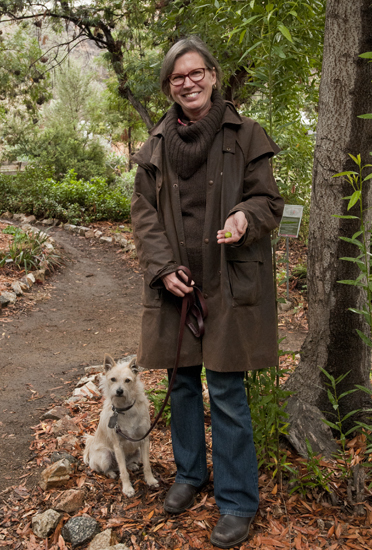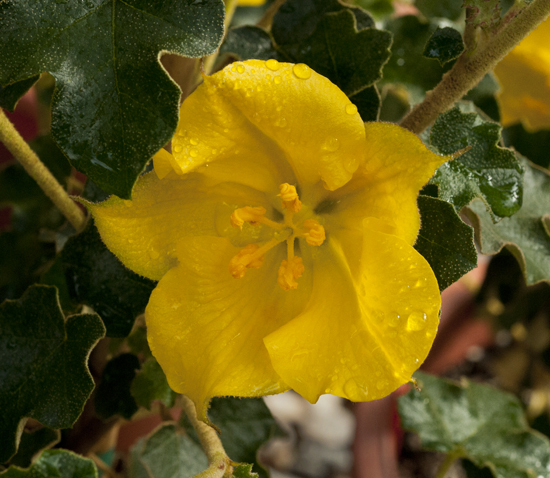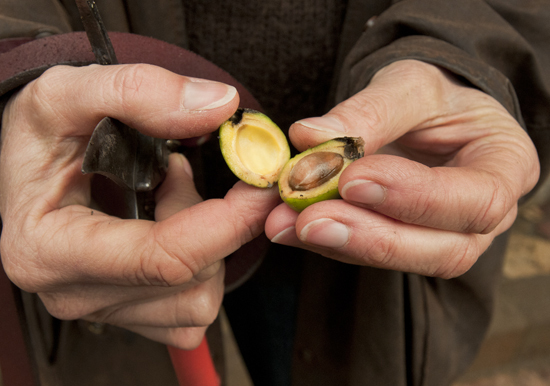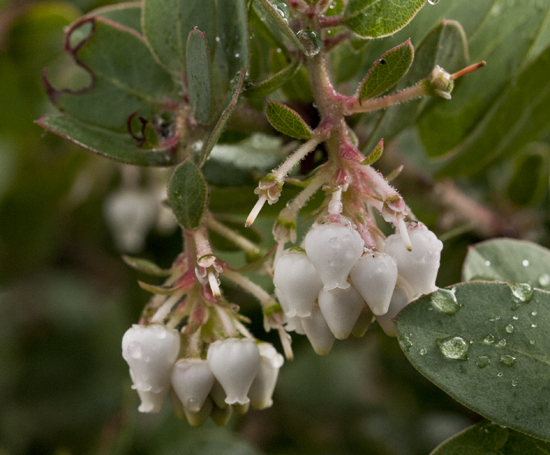This post was co-authored by Cathy Weiss, artist and educator living in Laurel Canyon.
The Theodore Payne Foundation is a great place to visit. Theodore Payne moved to Southern California from England in 1893, and while working as a gardener on a local ranch, he grew to love the special beauty of our native plants. He felt that most people did not appreciate their beauty or their value to the local ecology. As the city grew, natives were quickly being replaced with imported plants like palm trees, eucalyptus, bougainvillea, and roses. In response, Theodore Payne opened a nursery with native plants and seeds, and he helped design native wildflower gardens at Exposition Park, Griffith Park, Descanso Gardens, and many other places. If you visit the Foundation today, you can see hundreds of varieties of native plants in the nurseries, learn about the Native Americans indigenous to Southern California, and practice twisting rope out of reeds. Here we interview Lisa Novick, The Foundation's Director of Outreach and K-12 Education: Lisa not only studies native plants, she has made them an important part of her family's home.
For information about visiting, see http://www.theodorepayne.org/
Lisa Novick by ariellbphoto.com
Can you tell us something about the Foundation?
Theodore Payne wanted to honor and cherish the California landscape as nature made it. When he came here in 1893 he saw people chopping oaks, plowing under poppy fields, planting species not native to California. He fell in love with matilija poppies, wildflowers, and fields of lupine. He saw people ignoring those and rushing to plant exotic species. He spent his entire life trying educate people about the native flora of California and awaken them to the beauty we're losing and that works so well for our climate and soil types - the hot, dry summers, cool rainy winters. There are over 3,000 species and sub-species of California native plants. The different exposures on mountains, our four mountain ranges west to east, our varied distances from the equator - all these different exposures make different habitats. We have geological and landform richness - we are a biodiversity hotspot almost as good as the Amazon. Most of my own kids' classmates knew incredible facts about Amazon, but didn't know anything about the plants and animals in our own backyard.
Why are native plants important?
Did you know if you plant certain plants, you can attract butterflies and hummingbirds, and you will be helping them survive? 90 percent of insects have co-evolved with plant species native to their region, and can only digest that combination of chemicals. Insects are essential as pollinators, food for other insects and animals, and decomposers. Insects are the foundation of any food web. The caterpillars of most butterflies and moths can only eat a few types of native plants. Without those plants, they go extinct. Butterflies and moths are important because they are pollinators and their caterpillars are the main food of baby birds. Without caterpillars, we lose birds. In the U.S., populations of many bird species have fallen between 60-90 percent in the last forty years.
A native oak feeds up to four hundred species of beneficial insects, where a non-native maple feeds relatively few. Native plants also use much less water.
What can we do as individuals to help our ecosystem?
We are entering the sixth mass extinction on Earth, and this one is because of human activity. The other five were from natural causes. The extinction rate now is 1,000 times the normal background extinction rate. What we do in our urban and suburban areas with our landscaping is hugely important. Doug Tallamy wrote a beautiful book called Bringing Nature Home, which talks about how we can use our residential neighborhoods to restore native habitats, even in small ways.
What do we need to do?
Only 4 percent of the US is left as wild land. 41 percent of our land is agricultural use, and 55 percent is urban and suburban usage. How we use our gardens and landscaping is hugely important for stopping species loss, and providing homes for the bees and pollinators who service the insects and animals whose ecosystem services we need for our own wellbeing. For instance, birds give us seventeen different services, including reforestation and pest control. Without birds, we would lose a lot of beauty and all the things they do for us for free. A butterfly garden can feed butterflies and caterpillars. It takes 450-600 insects or worms to feed a family of four baby birds from the time they hatch until they fledge seventeen days later. Native plant gardens make thirty-five times the number of caterpillars of non-natives. Celebrate the holes in your leaves - non-native gardens usually have little bird or insect life. Holes in plant leaves mean that someone - an insect or bird - is actually there eating. A garden with no holes is a dead garden.
What influenced your appreciation of nature?
What made a huge difference was the first time I spent real time in a forest. Before fifth grade, I went to summer camp, where we slept in a teepee and woke up to dozens of different bird calls and the wind moving through the leaves and forest sounds instead of helicopters, car horns, and traffic noises. Being serenaded in the morning was beautiful and had never happened to me. When my own kids were born I started seeing climate change affecting species loss and habitat loss and making species numbers plummet. So many problems seemed so overwhelming - there was so much bad news out there. Habitat restoration using native plants is something everybody can do no matter where they live - on a balcony, parkway strip, or little hillside behind a house. Anyone can do this. We can bring nature back. That's the restorative, positive message about why gardening with native plants is so essential for our souls and our planet - the beauty has been here all along and can be here again if we nurture it.
How has LA changed during your years of living and working here?
I grew up in west LA and saw migrations of painted lady butterflies - we don't see that any more because we have lost the habitats. You can see them in the desert because the desert is more intact. Not only has the landscape changed, but I think people's appreciation for what's still here has changed - people seem to be less aware of what's here than they were. Years ago, people would have understood that there are trees that are native to LA. Now, at outreach events, people at city government say, 'There are no trees native to LA.' The level of disconnect to the natural environment seems larger and larger and makes our education efforts even more crucial.
What should children know about making a positive contribution?
Children have it in their power to do something right now to make the world better - by planting even one native plant in their backyard or parkway or in a container. That one plant can support insects and butterflies. When that plant's flowers are pollinated, those will become seeds or berries or nuts of some kind, and those will feed birds - either migrating birds or those that live here full time, and will feed a host of other insects as well. Plant just one in your yard, and you can begin to see the ecology shift.
How have you changed from doing this work?
Working here has been a privilege because I am constantly around other people who know so much, and I see all the different native plants that our production crew is propagating. I get to see new species and subspecies all the time and learn about them. There's always a new butterfly I notice feeding on a plant. There are 1,600 known species of California native bees. I've only seen a couple dozen. Some are emerald green and fuzzy, others are pewter colored. Native bumblebees are black and yellow striped, or mostly striped with one little yellow stripe - there are all sizes, shapes, and colors. That variety is what people need to understand.
Can native gardens help us with the crisis in bee health and pollination?
Native gardens give you all different types of pollinators by their sizes and shapes. There are different shaped insect bodies with hair on different parts of their bodies, and the those sizes and shapes attract different pollen grains and take on different flowers. You will get a better yield from your vegetable garden if you have native flowers around it. This will work better than if you just have European honey bees, with only one shaped body. Working here has exposed me every day to more and more richness of the local natural environment, and I know this is possible for everyone. We shouldn't have to drive to Joshua Tree or Yosemite to experience the beauty of nature in our yards.
What is your own garden like?
When I moved into our La Canada house, there was grass and roses and Mandevilla and thirsty willows. The landscaping was shamrock green, and there was hardly a bird or bee to be seen anywhere in that garden. It satisfied conventional perceptions of what's pretty, but if you sat and waited for birds or butterflies to come in, they didn't. There were no food sources for them. So we killed the lawn and let the dogs girdle the English willow tree. We replaced it with a native elderberry that our kids made into giant green cave. It has platter-sized clusters of blossoms that are butterfly landing pads in summer. When pollinated, it grows big bunches of berries that are delicious off the tree or in pies. We planted a Toyon shrub, native bunch grasses; we ripped out privet and planted native cherry trees for an informal hedge. Blue jays zoom in all the time to eat the cherries, and so do our daughters. We have native grape, buckwheat, and sage. In our front yard we killed the Bermuda lawn and planted a native garden. Amongst it all I have a vegetable garden. It all works together and complements each other.
Is there a story that demonstrates the joy a garden can bring?
Theodore Payne Foundation and L.A.'s Best were involved in planting a native and edible garden at an elementary school in North Hollywood that had just been moth-eaten Bermuda grass area with a sickly walnut tree remnant from the old groves. We installed a native garden with a line of edible boxes around the edge. We put in about 20 penstemons. As we were watering the garden with the kids, a hummingbird zoomed in and went from plant to plant to plant feeding from all the flowers. He took up residence in the walnut tree and built a nest. The kids were over the moon. I had told them, if you plant them, they will come - everything will follow. The kids wondered, 'is this really true,' and the hummingbird zoomed right in
Try this:
Plant a bush for butterflies. Manzanita plants come into flower at exactly nesting time - that's an example of co-evolution. A tiny insect as big as a pinhead lives in the flower, and that's what parent birds feed their babies.
Did you know?
Hummingbirds use fuzz from the back of sycamore leaves and clean spider webs to make their nests.
Did you know?
Mother butterflies can smell from up to seven miles away the chemical signal of the kind of leaf they need to lay their eggs. If they can't find it, they will lay their eggs on what smells as close as possible. But if the caterpillar digestive system has not co-evolved with that particular ratio of chemicals, usually the caterpillar will die - it can't digest the leaves. Butterflies prefer certain plants that they have co-evolved with in their own eco niche. There are over 90 specific California species that will only lay their eggs on certain species of leaf, like the monarch on milkweed, because that's what the caterpillars can eat.
That's why it's important, when planting butterfly gardens, to think about what the babies will eat in addition to nectar for the adults.


